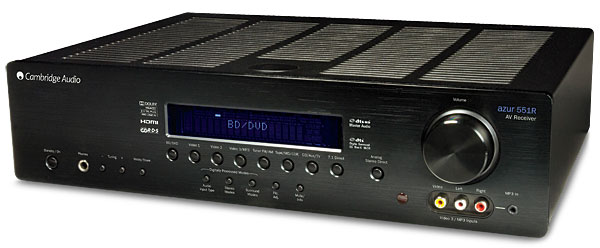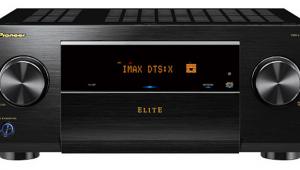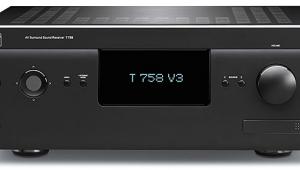Cambridge Audio Azur 551R A/V Receiver Page 2
 Mission Incomparable
Mission Incomparable
The Azur 551R is the kind of receiver that gets off on the right foot and never falters. It offers a degree of transparency that’s rare at this price point. I was consistently impressed by its clean output in every part of the frequency spectrum—but especially by its effortlessly sweet and airy highs. No, we’re not talking about etching or imbalance, just the pleasurable sensation of hearing high frequencies ascend naturally out of the presence region and reach for the stars. This is a true music lover’s receiver, and like others of its kind, it also handled movies superbly.
The 551R’s ability to handle a punishingly wide dynamic range became immediately apparent in the Tom Cruise vehicle Mission: Impossible—Ghost Protocol (Dolby TrueHD). When a Russian jailbreak turns into a riot, the receiver kept multiple layers of aggressive effects in good order, allowing Frank Sinatra to soar ironically over the top. Demolitions of cars and Kremlin buildings were potent but controlled in the frequencies just above the 80-hertz crossover I use with the Paradigms. Output was equally clean at lower volumes, allowing dialogue to come through with the same clarity as the effects. Strutting its musical adeptness, the Cambridge made certain that frequent reiterations of Lalo Schifrin’s classic Mission: Impossible theme were never anything less than a pleasure.
Tinker Tailor Soldier Spy (DTS-HD Master Audio) refocused my attention from the quantitative to the qualitative. In other words, dynamics didn’t matter as much, but texture was everything. The 551R thrived on a score that has various solo instruments—cornet, clarinet, oboe—floating above a cushion of strings. It rendered these instrumental voices so vividly that I could happily have closed my eyes and just listened to the movie. I wouldn’t have missed much of the plot with my eyes closed: Dialogue, often at extremely low and sinister levels, was as clear as a bell. When my eyes were open, however, the dimensions of the soundfield uncannily matched what I saw onscreen as the movie moved among its different spaces.
In The Debt (DTS-HD Master Audio), the Cambridge continued to excel with music, giving the string orchestra a plangent glow that was memorable in itself, with a gently drawn outward shape filled with inner beauty. Again, hushed dialogue came through, and all voices were gently filled out with timbre that was not hyped but subtly present, like a kind of verbal chamber music.
Upward Spiral
In 1999, Philips recorded the multichannel demo disc Budapest Live, with Ivan Fischer conducting the Budapest Festival Orchestra, to show off the emerging SACD format. Like most A/V receivers, the Azur accepted what was originally a DSD signal, only in the form of high-resolution PCM. This collection of short pieces, dominated by sprightly Eastern European dances, let the receiver define a great performance in a multitude of ways. In Bartók’s “Romanian Folk Dances,” as the emphasis shifted from the violins and violas to the cellos and basses, the Azur 551R seemed to take on an entirely different personality—warm, dark, and rich—then reverted to its usual balanced
state when the higher strings re-emerged. Kodály’s “Magnificat” featured a shimmering, luminous, three-dimensional choral sound that reached well beyond the speakers and nearly took my breath away as it faded to silence.
The last two selections were on vinyl. Van Morrison’s Saint Dominic’s Preview was entirely shorn of reverb—how very 1972—allowing the receiver to concentrate on rhythm. I’m not talking about a heavy rhythm section so much as a kind of snap and momentum that affected every instrument. In addition to this exemplary sense of pacing and drive, the Cambridge also imaged like a champ, scrupulously placing each instrument across the stereo soundstage. Morrison must have been an inspiring bandleader in those days. This band went on to record a stellar live album (It’s Too Late to Stop Now).

Spiral is a brilliantly unorthodox album by Muhal Richard Abrams recorded live at the Montreux Jazz Festival. The great jazz musician and composer started off playing piano solo, then reached inside to scrape and pluck the strings, and finally abandoned the piano and attacked a host of other percussion instruments. It was at this point that my jaw hit the floor and bounced several times. The “Paiste tuned sound set” Abrams was using seemed to consist of gongs, cymbals, and chimes. The gongs and cymbals hissed with menacing snarls, the kind of full-bodied metallic sound that is best supported by an analog or other high-resolution recording delivered by great amplification and speakers. But it was the chimes, with their long sustain and phosphorescent harmonics, that best showed off the receiver’s high-frequency response. Even with my poor man’s Shure phono cartridge, it was mesmerizing. I wondered how much better it might have been if I hadn’t broken the cantilever off my V15MxR.
By prioritizing performance over features, Cambridge Audio’s Azur 551R A/V receiver makes a different value proposition to the consumer. Those who absolutely must have room correction and network audio features should look elsewhere. But those who are perplexed—or even put off—by the perpetual AVR features race might be heartened by a product that concentrates on sound quality above all else. Those with more demanding speakers may also want to take a long, hard look at this receiver and its higher-powered sister models. If you want a closer relationship with music and movies—and are willing to overlook the absence of bells and whistles—this AVR will take you to the heights.
























































